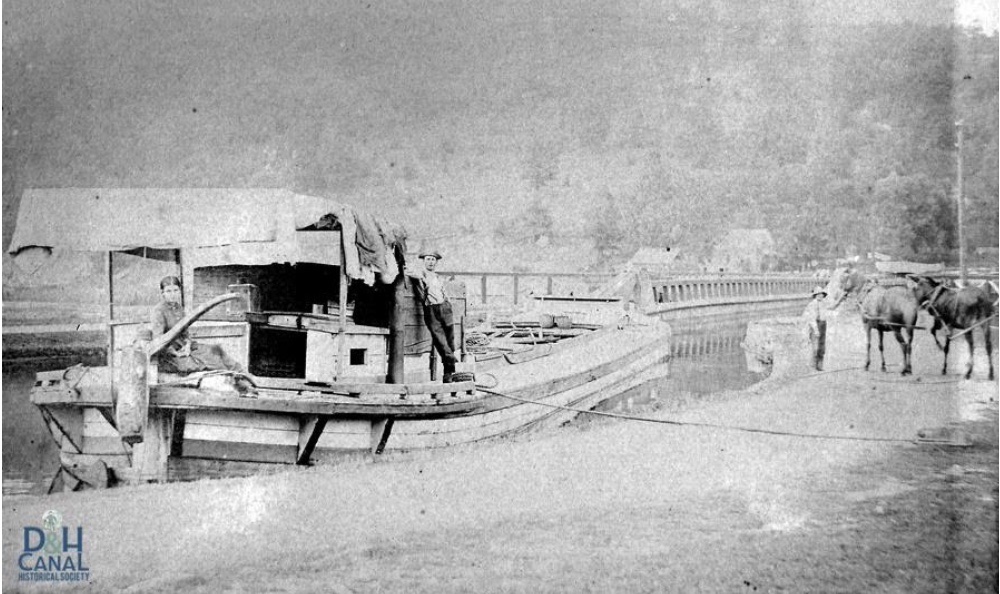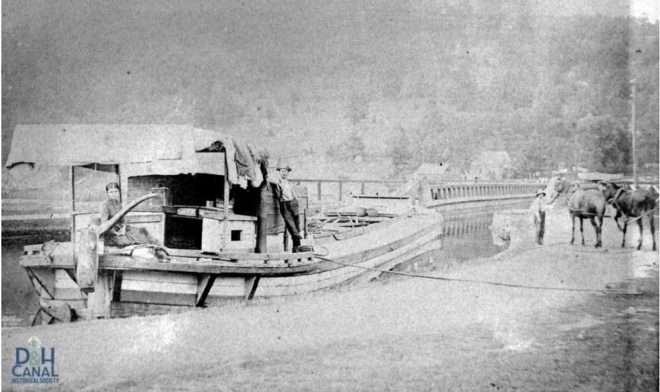“…both the small boats on the old canal, and the large boats on the new canal, substitute women and girls for men and boys, and we often find them the best boatmen.”
– D&H employee Lorenzo Sykes, in his 1858 court testimony

Conducting research into the lives of marginalized workers on the D&H Canal is difficult, and the hardest group to find information on is women, though their work was necessary to run the Canal. In his study of the workers digging the early North American canals, Common Labor, Peter Way wrote, “Women rarely figure in the primary sources that have survived, having been, even more so than male workers, silenced by history”. Yet they were an important component of the overall workforce. “Women worked on the periphery of canal construction, serving men as cooks, cleaners and laundresses in the shanty camps, usually in the pay of contractors at wages considerably below those of men.” What was true of women during construction continued throughout the entire canal era. Way continues “…their secondary status in patriarchal society meant they could be more fully exploited than men… they were always treated as second-class producers solely because of their gender…” They were prevalent- at least a third of the population in canal settlements. “As canallers were not paid enough to support a family, wives and children had to work to survive.” Women and children were employed because they accepted lower pay than the other marginalized workers, immigrants and people of color. Mule driving didn’t require much manual skill beyond the ability to walk, no faster than three mph, for long stretches of time, and was a position almost solely filled by children, male and female. Steering a boat required more brains than brawn- pictures from the last quarter of the 19th century frequently show women at the tiller of what was usually their family’s canal boat. In the last quarter century of operation, the D&H Canal boat crews were often whole families, whose pooled labor allowed them to subsist on the meager pay. The price paid to the boatmen fell to a low of $.60 a ton in 1878 after having paid a dollar a ton in 1871. When asked what work his wife did on board his Canal boat, captain Alpheus Galloway testified that, “She used to cook and tend to the things on the boat which had to be done, cleaning &c., steering the boat occasionally to spell us when required, and in watching the boat when we were lying still.”
Women often had a hard time finding work. On October 19, 1876, the Honesdale Citizen reported that a woman was discovered on a D&H Canal boat dressed as a man and “…regularly employed as part of the crew.” Unfortunately this is all we know- you wonder if she kept working. Peter Way wrote “Two nameless Irishwomen dressed in men’s clothing to work as quarriers on the Chesapeake and Delaware line, but quickly left when they discovered the lack of accommodations for workers there.” Some women resorted to impersonating men, presumably to get better pay.
Women were not just found on the Canal boats but were also employed at various businesses along the entire route. On April 25, 1878, The Honesdale Citizen reported on an altercation at Langendorfer’s Hall in Texas Township, PA, with some 40 or 50 participants. One side “…rallied under the leadership of a woman, armed with a hammer, every blow of which fell with telling effect on the canallers, causing many a bloody nose and sore head.” There was no indication of the cause of the fight nor further information on the outcome!
by Bill Merchant, D&H Canal Historical Society
published March 3, 2021 in the Kingston Wire
(The author wishes to recognize and thank the Ulster County Community Grants Fund of the Community Foundations of the Hudson Valley for their initial funding for this research.)
